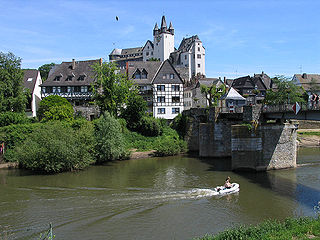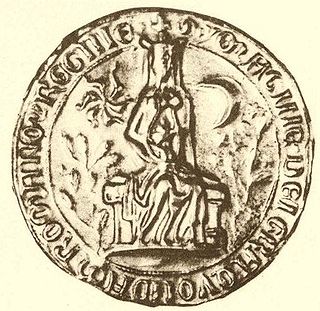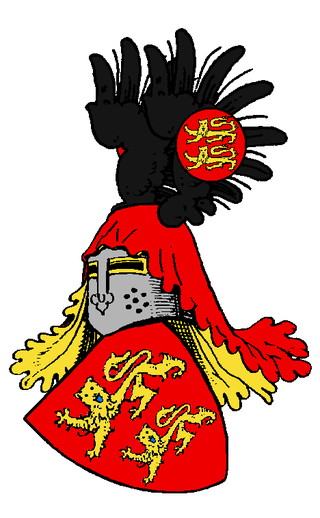Life
Gerlach was the son of Henry (Heinrich) I of Isenburg-Grenzau and his wife, Irmingard of Büdingen, Countess of Cleeberg (now part of Langgöns). Gerlach was a namesake of a senior Gerlach of Isenburg who served as Vogt of the Archbishopric of Trier from c. 1130 to 1147.
After the death of his father, Henry I, in ca. 1227, Gerlach reigned jointly with his brother Henry II over the paternal inheritance. From 1247, Gerlach took the title of “Lord of Limburg.” On May 22, 1258 the division of the inheritance was finally sealed: Gerlach won the dominion of Limburg and Henry II the Countship of Isenburg-Grenzau as their sole possessions.
From a trip to Italy in 1231, Gerlach brought monks of the Franciscan Order to whom he gave permission to construct a monastery in Limburg. This makes it one of the oldest Franciscan monasteries in Germany (the first being at Augsburg in 1221). The monastery was later endowed by the House of Limburg.
As the Lord of Limburg, Gerlach joined the opponents of the Hohenstaufen. He was probably involved in the looting of Worms in 1243/44. After the Great Interregnum (1254–1273), Gerlach supported King Rudolph of Habsburg. In 1276, he was commissioned by the king to confirm the Counts of Diez in their imperial fief.
In 1279, there was an uprising of the citizens of the town of Limburg, and Gerlach was expelled from the city. After negotiations, he was able to return to his castle in Limburg, but he had to grant the citizenry far-reaching freedoms. These freedoms included a pause in the collection of taxes and self-jurisdiction of marriages and housing. In the case of a dispute between the House of Limburg and the city, it would be decided by the jury of the City of Frankfurt. Upon his return, Gerlach expanded Limburg Castle, building the residential tower which is still extant today.
To secure his position, Gerlach sought dynastic connections with neighboring lordly houses, including Nassau, Westerburg, and Diez. His daughter Agnes married Henry I of Westerburg in 1267. Around the year 1270, his daughter Imagina married Count (and later King) Adolf of Nassau. By Adolf of Nassau, Gerlach was appointed Burgmann of the Imperial Castle of Kalsmunt in Wetzlar in 1287. On June 5, 1288 Gerlach, together with Adolf of Nassau and Henry of Westerburg, participated in the Battle of Worringen. They supported Henry of Westerburg's brother, Siegfried, the Archbishop of Cologne. Siegfried’s defeat in the battle had no significant consequences for Gerlach.
Gerlach I of Limburg died in 1289 during his participation in a campaign of King Rudolph in the Black Forest. He was succeeded by his son, John I.

Limburg an der Lahn is the district seat of Limburg-Weilburg in Hesse, Germany.

Adolf was the count of Nassau from about 1276 and the elected king of Germany from 1292 until his deposition by the prince-electors in 1298. He was never crowned by the pope, which would have secured him the imperial title. He was the first physically and mentally healthy ruler of the Holy Roman Empire ever to be deposed without a papal excommunication. Adolf died shortly afterwards in the Battle of Göllheim fighting against his successor Albert of Habsburg.

The County of Isenburg was a region of Germany located in southern present-day Hesse, located in territories north and south of Frankfurt. The states of Isenburg emerged from the Niederlahngau, which partitioned in 1137 into Isenburg-Isenburg and Isenburg-Limburg-Covern. These countships were partitioned between themselves many times over the next 700 years.

Diez an der Lahn is a town in Germany's Rhein-Lahn district in Rhineland-Palatinate, on the borders of Hesse. Diez is the administrative seat of the municipality of Diez.
Otto I of Nassau was Count of Nassau and is the ancestor of the Ottonian branch of the House of Nassau.
Isenburg-Grenzau was the name of several states of the Holy Roman Empire, seated in the Lordship of Grenzau, in modern Rhineland-Palatinate, Germany. The first state called Isenburg-Grenzau existed 1158–1290; the second 1341–1439; and the third 1502–1664.

Imagina of Isenburg-Limburg was the Queen consort of Adolf of Nassau, King of Germany.
Klarenthal Abbey is a former convent of the Order of Poor Ladies in the borough of Klarenthal in Wiesbaden, Germany. Klarenthal is the only abbey in present-day Wiesbaden.
The Countship of Isenburg-Limburg was a state of the Holy Roman Empire in the 13th and 14th centuries, based around the city of Limburg an der Lahn in modern Hesse, Germany.

John I of Isenburg-Limburg, "The blind Lord" was from 1289 Count of (Isenburg-) Limburg and the head of the House of Limburg. The core territory of the Lordship of Limburg consisted of the city of Limburg an der Lahn and several surrounding villages.
Gerlach V of Isenburg-Limburg, also called Gerlach II "the Elder" of Limburg, was Count of Isenburg-Limburg. He reigned between 1312 and 1355 as Lord of Limburg an der Lahn, and the head of the House of Limburg. The chronicler Tilemann Elhen von Wolfhagen describes him, in his pre-1402 Limburger Chronicle, as a virtuous nobleman and a bright poet in German and Latin.

SiegfriedII of Westerburg was Archbishop of Cologne from 1275 to 1297.
John II of Isenburg-Limburg was Lord of Limburg an der Lahn and the last Count of Isenburg-Limburg from 1365 until 1406. He is sometimes designated John III to differentiate him from his non-ruling older half-brother John II.

The Lahngau was a medieval territory comprising the middle and lower Lahn River valley in the current German states of Hesse and (partially) Rhineland-Palatinate. The traditional names of the Gau are Loganahe Pagus or Pagus Logenensis.

Henry I of Nassau-Siegen was Count of Nassau-Siegen, a part of the County of Nassau, and ancestor of the House of Nassau-Siegen. He comes from the Ottonian branch of the House of Nassau.

The County of Diez was a county of the Holy Roman Empire, centred around Grafenschloss in Diez, located in Lahngau. The county is first recorded in 1073, likely formed from the lands of the Conradine dynasty after their relocation to Swabia. The Counts of Diez gained prominence in the late twelfth century as strong supporters of the Hohenstaufen dynasty, earning it the nickname "Golden County."

The Grenzau Feud was a warlike conflict between the troops of Koblenz in the Electorate of Trier on the one hand and Lord Philip of Isenburg and Lord Reynard of Westerburg on the other at Grenzau on 20 April 1347. The Koblenz soldiers were ambushed and 172 were killed.

The Barony of Westerburg, a small principality around the present day town of Westerburg in the Westerwald mountains of Germany, is first recorded in 1209. The eponymous castle, which had probably been built earlier than when it was mentioned for the first time in 1192, was the family seat of the lords of Westerburg, a branch of the lords of Runkel.
This page is based on this
Wikipedia article Text is available under the
CC BY-SA 4.0 license; additional terms may apply.
Images, videos and audio are available under their respective licenses.












